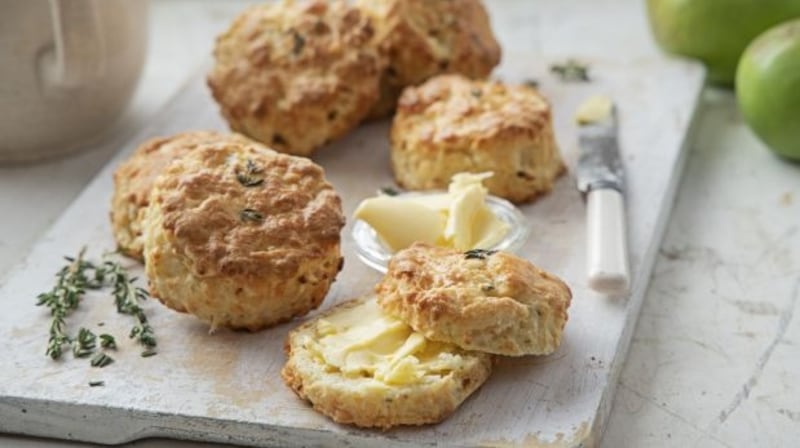The online rumpus about the €10 charged for three mini scones, a one-person serving, at an Irish hotel last weekend may have shocked some readers. But the rest of us just wanted scones, hot, fluffy, scones with butter, jam and cream - at any price. Immediately.
Happily, given the straightened times we are in, a batch can be whipped up at home in minutes, by the most inexperienced cook, and for a fraction of the hotel cost. You won’t get the fancy silverware and china, unless you provide it yourself, and you’ll have to conjure up the atmosphere and setting yourself too, but you’ll save a packet.
Hungry anticipation had us delving into the Irish Times Food archive in search of inspiration, and Vanessa Greenwood’s recipe for the perfect Irish scone fits the bill.
And the cost? Using Tesco’s own brand organic strong flour (63 cent); butter (32 cent), milk (17 cent) and free range eggs (58 cent), the cost for eight large scones comes out at €1.70 for the batch, or around 21 cent per large scone. These calculations don’t include the energy cost for baking. Or the butter, jam and cream or clotted cream that you’ll pile on top, in whatever order you prefer (but to be honest nothing other than butter, then jam, then cream, makes any sense).
When this recipe was first published, the quantity of baking powder used, one tablespoon, raised eybrows, with some readers assuming it should be one teaspoon. But according to Greenwood, an experienced cookery tutor, the recipe is correct.
“My recipe uses strong flour (which doesn’t have an in-built raising agent). So for the scones to rise brilliantly, as well as baking them in a hot oven, we have a few options: for example you can use bread soda (bicarbonate of soda) in the dry ingredients, plus something acidic like buttermilk. Or, as in my recipe, use the tablespoon of baking powder in the dry ingredients, which means you can use regular milk rather than buttermilk. If you don’t have strong flour, you can also use plain flour.”
According to Greenwood, treat your scone dough gently for the best results. “The most important thing to remember when making scones is to handle the dough with the lightest touch. Never ever knead the dough or the scones will be tough.
“Chefs dip the scone cutter in some flour before stamping out each scone. It’s a handy trick when the moist scone dough might otherwise get stuck inside the cutter.”
If you prefer a savoury scone, perfect with a bowl of soup, you could try Aoife Noonan's apple, cheddar and thyme scones.
Vanessa Greenwood’s perfect Irish scones
Makes eight
Ingredients
350g strong white flour (or plain flour)
1 tbsp baking powder
Generous pinch salt
60g cold butter, diced small
200ml milk
1 egg (plus an extra yolk for glazing)
Method
1 Preheat oven to 220 degrees (fan). Line a baking sheet with parchment paper (or dust well with flour).
2 In a large mixing bowl, sieve together the dry ingredients (flour, baking powder and salt).
3 Rub the butter in by hand until the mixture resembles fine breadcrumbs (I prefer to use a food processor for this step).
4 Mix together the egg and milk.
5 Make a well in the centre of the dry mixture, then pour in three-quarters of the liquid, lightly stirring in both directions to combine. Add the remaining liquid, using it to draw in any excess flour from the sides of the bowl (avoid overmixing).
6 Flour your hands and tip the soft, raggy dough on to a very well-floured work surface. Shape and gently pat the dough to an even 2cm thickness.
7 Use a 7cm round scone cutter to stamp out scones, transfer them to the lined baking sheet and brush the tops with egg yolk to glaze.
8 Bake on the middle shelf of the preheated oven, first at 220 degrees for eight to 10 minutes (for large scones) until they rise upwards, without burning, then immediately reduce the heat to 160 degrees for another 10 minutes to bake fully.
9 Once baked, remove from the oven and transfer to a wire rack to cool.
Variation:
For sweeter scones, add four tablespoons of sugar to the dry mixture, or a handful of sultanas or frozen raspberries.

Aoife Noonan’s apple, cheeddar and thyme scones
Makes 8
Ingredients
235g self raising flour
¾ tsp salt
1 tsp baking powder
25g unsalted butter, cubed
150g grated mature cheese
1 tsp chopped thyme
1 large (about 150g) eating apple, chopped or grated~
2 eggs
115ml milk
Method
1 Preheat the oven to 200 degrees or 180 degrees if using a fan oven. Line a baking tray with parchment paper.
2 In a large mixing bowl, sieve together the flour, salt, and baking powder.
3 Add the butter and rub in with your fingers until it resembles fine breadcrumbs. Add the grated cheese, chopped apple, and thyme, mixing well to combine.
4 Crack one of the eggs into a bowl and whisk together with 100ml of the milk. Mix just until the dough comes together. Dust the work surface with a little extra flour, turn out the dough, and roll out until you have a 18cm circle.
5 Cut out eight scones using a 6cm circle cutter and place on the baking tray. Whisk the remaining egg with the 15ml milk and brush the tops of the scones with a little of the egg wash.
6 Bake the scones for 20 minutes until the tops are beautifully golden brown. Cool slightly before serving.










